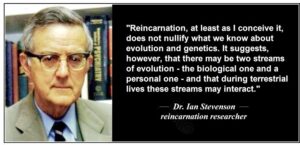Dr. Ian Stevenson (1918-2007) was a psychiatrist who worked for the University of Virginia School of Medicine for 50 years. He was Chair of the Department of Psychiatry from 1957 to 1967, the Carlson Professor of Psychiatry from 1967 to 2001, and a Research Professor of Psychiatry from 2002 until his death. He was also the founder and Director of the University of Virginia’s Division of Perceptual Studies investigating parapsychological phenomena such as (1) reincarnation, (2) near-death experiences, (3) out-of-body experiences, and (4) altered states of consciousness and psi. He became internationally recognized for his research into reincarnation by discovering evidence suggesting that memories and physical injuries can be transferred from one lifetime to another. He traveled extensively over a period of 40 years, investigating 3,000 cases of children around the world who recalled having past lives. His meticulous research presented evidence that such children had unusual abilities, illnesses, phobias and philias which could not be explained by the environment or heredity.
1. Introduction to Dr. Ian Stevenson’s Research
Dr. Stevenson’s reincarnation research began in 1960 when he learned of a case in Sri Lanka where a child reported remembering a past life. He thoroughly questioned the child and the child’s parents, including the people whom the child recalled were his parents from his past life. This led to Dr. Stevenson’s conviction that reincarnation was possibly a reality. That same year, Dr. Stevenson published two articles in the Journal of the American Society for Psychical Research about this child who remembered having a past life. The more such cases he discovered, the greater became his ambition to scientifically quantify the possibility of reincarnation – one of the world’s greatest mysteries – which had been virtually ignored by science in the past.
In 1982, Dr. Stevenson co-founded the Society for Scientific Exploration. He authored around 300 papers and 14 books on the subject of reincarnation. His 1966 book, “Twenty Cases Suggestive of Reincarnation,” became a classic in the annals of reincarnation research. In 2003, Dr. Stevenson published his second book on reincarnation, “European Cases of the Reincarnation Type“. In 1997 he published his major classic: the 2,268-page, two-volume book, “Reincarnation and Biology: A Contribution to the Etiology of Birthmarks and Birth Defects,” which focused mostly on deformities and other anomalies children are born with which cannot be traced back to inheritance, prenatal or perinatal (created during birth) occurrences. This monumental classic contains hundreds of pictures presenting the evidence he discovered. It documents 200 cases of children having memories and birthmarks which corresponded with the lives and wounds of deceased people whom these children recalled as having lived in a past-life. In 1997, Dr. Stevenson published a condensed version of this book for the general public entitled, “Where Reincarnation and Biology Intersect.” Dr. Stevenson’s research into reincarnation also became the subject of two important works, “Old Souls: Compelling Evidence from Children Who Remember Past Lives” authored by Tom Shroder (a Washington Post journalist) and “Life Before Life: Children’s Memories of Previous Lives” authored by Dr. Jim B. Tucker (www.jimbtucker.com) a psychiatrist at the University of Virginia. Many people, including skeptics and scholars, agree that the cases presented by Dr. Stevenson offer the best evidence yet for reincarnation.
During his original research into various cases involving children’s memories of past lives, Dr. Stevenson did note with interest the fact that these children frequently bore lasting birthmarks which supposedly related to their murder or the death they suffered in a previous life. Stevenson’s research into birthmarks and congenital defects has such particular importance for the demonstration of reincarnation, since it furnishes objective and graphic proof of reincarnation, superior to the – often fragmentary – memories and reports of the children and adults questioned, which even if verified afterwards cannot be assigned the same value in scientific terms.
In many cases presented by Dr. Stevenson there are also medical documents available as further proof, which are usually compiled after the death of the person. Dr. Stevenson adds that in the cases he researched and “solved” in which birthmarks and deformities were present, he didn’t suppose there was any other apposite explanation than that of reincarnation. Only 30% to 60% of these deformities can be put down to birth defects which related to genetic factors, virus infections or chemical causes (like those found in children damaged by the drug Thalidomide or alcohol). Apart from these demonstrable causes, the medical profession has no other explanation for the other 40% to 70% of cases than that of mere chance. Stevenson has now succeeded in giving us an explanation of why a person is born with these deformities and why they appear precisely in that part of their body and not in another.
2. The Five Common Characteristics in Most of Dr. Stevenson’s Study
Most of the cases, where birthmarks and congenital deformities are present for which no medical explanations exist, have one to five characteristics in common.
- In the most unusual scenario, it is possible that someone who believed in reincarnation expressed a wish to be reborn to a couple or one partner of a couple. This is usually because they are convinced that they would be well cared for by those particular people. Such preliminary requests are often expressed by the Tlingit Indians of Alaska and by the Tibetans.
- More frequent than this are the occurrences of prophetic dreams. Someone who has died appears to a pregnant or not as yet pregnant woman and tells her that he or she will be reborn to her. Sometimes relatives or friends have dreams like this and will then relate the dream to the mother to be. Dr. Stevenson found these prophetic dreams to be particularly prolific in Burma and among the Indians in Alaska.
- In these cultures the body of a newborn child is checked for recognizable marks to establish whether the deceased person they had once known has been reborn to them. This searching for marks of identification is very common among cultures that believe in reincarnation, and especially among the Tlingit Indians and the Igbos of Nigeria. Various tribes of West Africa make marks on the body of the recently deceased in order to be able to identify the person when he or she is reborn.
- The most frequently occurring event or common denominator relating to rebirth is probably that of a child remembering a past life. Children usually begin to talk about their memories between the ages of two and four. Such infantile memories gradually dwindle when the child is between four and seven years old. There are of course always some exceptions, such as a child continuing to remember its previous life but not speaking about it for various reasons.
Most of the children talk about their previous identity with great intensity and feeling. Often they cannot decide for themselves which world is real and which one is not. They often experience a kind of double existence where at times one life is more prominent, and at times the other life takes over. This is why they usually speak of their past life in the present tense saying things like, “I have a husband and two children who live in Jaipur.” Almost all of them are able to tell us about the events leading up to their death.
Such children tend to consider their previous parents to be their real parents rather than their present ones, and usually express a wish to return to them. When the previous family has been found and details about the person in that past life have come to light, then the origin of the fifth common denominator – the conspicuous or unusual behavior of the child – is becoming obvious. - For instance, if the child is born in India to a very low-class family and was a member of a higher caste in its previous life, it may feel uncomfortable in its new family. The child may ask to be served or waited on hand and foot and may refuse to wear cheap clothes. Stevenson gives us several examples of these unusual behavior patterns.
In 35% of cases he investigated, children who died an unnatural death developed phobias. For example, if they had drowned in a past life then they frequently developed a phobia about going out of their depth in water. If they had been shot, they were often afraid of guns and sometimes loud bangs in general. If they died in a road accident they would sometimes develop a phobia of traveling in cars, buses or lorries.
Another frequently observed unusual form of behavior, which Dr. Stevenson called philias, concerns children who express the wish to eat different kinds of food or to wear clothes that were different from those of their culture. If a child had developed an alcohol, tobacco or drug addiction as an adult in a previous incarnation he may express a need for these substances and develop cravings at an early age.
Many of these children with past-life memories show abilities or talents that they had in their previous lives. Often children who were members of the opposite sex in their previous life show difficulty in adjusting to the new sex. These problems relating to the “sex change” can lead to homosexuality later on in their lives. Former girls who were reborn as boys may wish to dress as girls or prefer to play with girls rather than boys.
Until now all these human oddities have been a mystery to conventional psychiatrists – after all, the parents could not be blamed for their children’s behavior in these cases. At long last research into reincarnation is shedding some light on the subject. In the past, doctors blamed such peculiarities on a lack or a surplus of certain hormones, but now they will have to do some rethinking.
The following paper by Dr. Stevenson was presented at the Eleventh Annual Meeting of the Society for Scientific Exploration held at Princeton University. June 11-13, 1992. The title of the paper is “Birthmarks and Birth Defects Corresponding to Wounds on Deceased Persons” (PDF) and provides perhaps the most compelling scientific evidence suggestive of reincarnation. Dr. Stevenson’s paper presents evidence that physical characteristics, such as birthmarks and deformities, may be carried over from a past life to a present life.
3. Birthmarks and Birth Defects Corresponding to Wounds on Deceased Persons
SOURCE: Dr. Ian Stevenson, Department of Psychiatric Medicine, University of Virginia, School of Medicine, Charlottesville, Virginia 22908
ABSTRACT: Almost nothing is known about why pigmented birthmarks (moles or nevi) occur in particular locations of the skin. The causes of most birth defects are also unknown. About 35% of children who claim to remember previous lives have birthmarks and/or birth defects that they (or adult informants) attribute to wounds on a person whose life the child remembers. The cases of 210 such children have been investigated. The birthmarks were usually areas of hairless, puckered skin; some were areas of little or no pigmentation (hypopigmented macules); others were areas of increased pigmentation (hyperpigmented nevi). The birth defects were nearly always of rare types. In cases in which a deceased person was identified the details of whose life unmistakably matched the child’s statements, a close correspondence was nearly always found between the birthmarks and/or birth defects on the child and the wounds on the deceased person. In 43 of 49 cases in which a medical document (usually a postmortem report) was obtained, it confirmed the correspondence between wounds and birthmarks (or birth defects). There is little evidence that parents and other informants imposed a false identity on the child in order to explain the child’s birthmark or birth defect. Some paranormal process seems required to account for at least some of the details of these cases, including the birthmarks and birth defects.
INTRODUCTION: Although counts of moles (hyperpigmented nevi) have shown that the average adult has between 15 and 18 of them (Pack and Davis, 1956), little is known about their cause — except for those associated with the genetic disease neurofibromatosis — and even less is known about why birthmarks occur in one location of the body instead of in another. In a few instances a genetic factor has been plausibly suggested for the location of nevi (Cockayne, 1933; Denaro, 1944; Maruri, 1961); but the cause of the location of most birthmarks remains unknown. The causes of many, perhaps most, birth defects remain similarly unknown. In large series of birth defects in which investigators have searched for the known causes, such as chemical teratogens (like thalidomide), viral infections, and genetic factors, between 43% (Nelson and Holmes, 1989) and 65-70% (Wilson, 1973) of cases have finally been assigned to the category of “unknown causes.”
Among 895 cases of children who claimed to remember a previous life (or were thought by adults to have had a previous life), birthmarks and/or birth defects attributed to the previous life were reported in 309 (35%) of the subjects. The birthmark or birth defect of the child was said to correspond to a wound (usually fatal) or other mark on the deceased person whose life the child said it remembered. This paper reports an inquiry into the validity of such claims. With my associates I have now carried the investigation of 210 such cases to a stage where I can report their details in a forthcoming book (Stevenson, forthcoming). This article summarizes our findings.
Children who claim to remember previous lives have been found in every part of the world where they have been looked for (Stevenson, 1983; 1987), but they are found most easily in the countries of South Asia. Typically, such a child begins to speak about a previous life almost as soon as it can speak, usually between the ages of two and three; and typically it stops doing so between the ages of five and seven (Cook, Pasricha, Samararatne, Win Maung, and Stevenson, 1983). Although some of the children make only vague statements, others give details of names and events that permit identifying a person whose life and death corresponds to the child’s statements. In some instances the person identified is already known to the child’s family, but in many cases this is not so. In addition to making verifiable statements about a deceased person, many of the children show behavior (such as a phobia) that is unusual in their family but found to correspond to behavior shown by the deceased person concerned or conjecturable for him (Stevenson, 1987; 1990).
Although some of the birthmarks occurring on these children are “ordinary” hyperpigmented nevi (moles) of which every adult has some (Pack and Davis, 1956), most are not. Instead, they are more likely to be puckered and scarlike, sometimes depressed a little below the surrounding skin, areas of hairlessness, areas of markedly diminished pigmentation (hypopigmented macules), or port-wine stains (nevipammri). When a relevant birthmark is a hyperpigmented nevus, it is nearly always larger in area than the “ordinary” hyperpigmented nevus. Similarly, the birth defects in these cases are of unusual types and rarely correspond to any of the “recognizable patterns of human malformation” (Smith, 1982).


METHODS: My investigations of these cases included interviews, often repeated, with the subject and with several or many other informants for both families. With rare exceptions, only firsthand informants were interviewed. All pertinent written records that existed, particularly death certificates and postmortem reports, were sought and examined. In the cases in which the informants said that the two families had no previous acquaintance, I made every effort to exclude all possibility that some information might nevertheless have passed normally to the child, perhaps through a half-forgotten mutual acquaintance of the two families. I have published elsewhere full details about methods (Stevenson, 1975; 1987).
I did not accept any indicated mark as a birthmark unless a firsthand witness assured me that it had been noticed immediately after the child’s birth or, at most, within a few weeks. I enquired about the occurrence of similar birth marks in other members of the family; in nearly every instance this was denied, but in seven cases a genetic factor could not be excluded.
Birth defects of the kind in question here would be noticed immediately after the child’s birth. Inquiries in these cases excluded (again with rare exceptions) the known causes of birth defects, such as close biological relationship of the parents (consanguinity), viral infections in the subject’s mother during her pregnancy, and chemical causes of birth defects like alcohol.
4. Correspondences Between Wounds and Birthmarks
RESULTS: A correspondence between birthmark and wound was judged satisfactory if the birthmark and wound were both within an area of 10 square centimeters at the same anatomical location; in fact, many of the birthmarks and wounds were much closer to the same location than this. A medical document, usually a postmortem report, was obtained in 49 cases. The correspondence between wound and birthmark was judged satisfactory or better by the mentioned criterion in 43 (88%) of these cases and not satisfactory in 6 cases. Several different explanations seem to be required to account for the discrepant cases, and I discuss these elsewhere (Stevenson. forthcoming). Figure 1 shows a birthmark (an urea of hypopigmentation) on an Indian child who said he remembered the life of a man who had been killed with a shotgun fired at close range. Figure 2 shows the location of the wounds recorded by the pathologist. (The circles were drawn by an Indian physician who studied the postmortem report with me.)
The high proportion (88%) of concordance between wounds and birthmarks in the cases for which we obtained postmortem reports (or other confirming documents) increases confidence in the accuracy of informants’ memories concerning the wounds on the deceased person in those more numerous cases for which we could obtain no medical document. Not all errors of informants memories would have resulted in attributing a correspondence between birth marks and wounds that did nor exist; in four cases (possibly five) reliance on an informant’s memory would have resulted in missing a correspondence to which a medical document attested.
5. Cases with Two or More Birthmarks
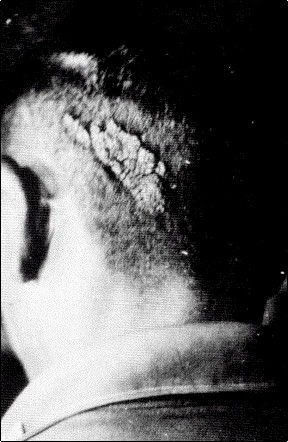
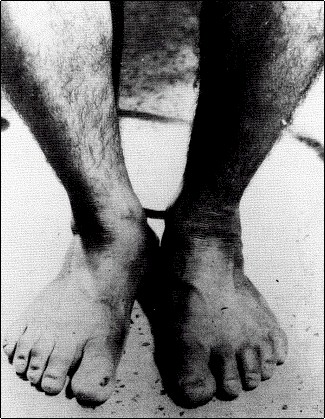
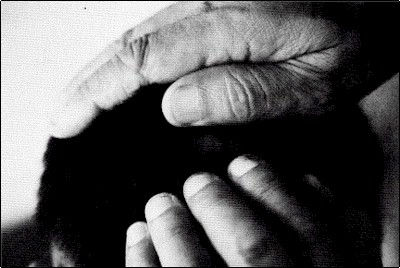
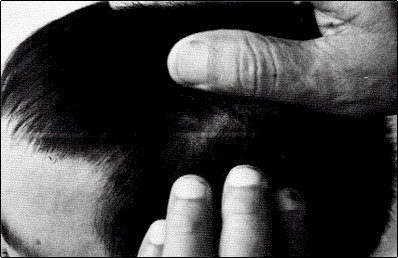
The argument of chance as accounting for the correspondence between birthmarks and wounds becomes much reduced when the child has two or more birthmarks each corresponding to a wound on the deceased person whose life he claims to remember. Figure 3 shows a major abnormality of the skin (verrucous epidermal nevus) on the back of the head of a Thai man who, as a child, recalled the life of his uncle, who had been struck on the head with a heavy knife and killed almost instantly. The subject also had a deformed toenail of the right great toe (Figure 4). This corresponded to a chronic infection of the same toe from which the subject’s uncle had suffered for some years before he died.
The series includes 18 cases in which two birthmarks on a subject corresponded to gunshot wounds of entry and exit. In 14 of these one birthmark was larger than the other, and in 9 of these 14 the evidence clearly showed that the smaller birthmark (usually round) corresponded to the wound of entry and the larger one (usually irregular in shape) corresponded to the wound of exit. These observations accord with the fact that bullet wounds of exit are nearly always larger than wounds of entry (Fatteh, 1976; Gordon and Shapiro, 1982). Figure 5 shows a small round birthmark on the back of the head of a Thai boy, and Figure 6 shows a larger, irregularly shaped birthmark at the front of his head. The boy said that he remembered the life of a man who was shot in the head from behind. (The mode of death was verified, but no medical document was obtainable.) In addition to the 9 cases I have investigated myself, Mills reported another case having the feature of a small round birthmark (corresponding to the wound of entry) and a larger birthmark corresponding to the wound of exit (both verified by a postmortem report) (Mills, 1989).
I have calculated the odds against chance of two birthmarks correctly corresponding to two wounds. The surface area of the skin of the average adult male is 1.6 meters (Spalteholz, 1943). If we were to imagine this area square and spread on a fiat surface, its dimensions would be approximately 127 centimeters by 127 centimeters. Into this area would fit approximately 160 squares of the size 10 centimeters square that I mentioned above. The probability that a single birthmark on a person would correspond in location to a wound within the area of any of the 160 smaller squares is only 1/160. However, the probability of correspondences between two birthmarks and two wounds would be (1/160)2 i.e. 1 in 25,600. (This calculation assumes that birthmarks are uniformly distributed over all regions of the skin. This is incorrect [Pack, Lenson, and Gerber, 1952], but I believe the variation can be ignored for the present purpose.)
6. Examples of Other Correspondences of Detail between Wounds and Birthmarks
A Thai woman had three separate linear hypopigmented scarlike birthmarks near the midline of her back; as a child she had remembered the life of a woman who was killed when struck three times in the back with an ax. (Informants verified this mode of death, but no medical record was obtainable.) A woman of Burma was born with two perfectly round birthmarks in her left chest; they slightly overlapped, and one was about half the size of the other. As a child she said that she remembered the life of a woman who was accidentally shot and killed with a shotgun. A responsible informant said the shotgun cartridge had contained shot of two different sizes. (No medical record was obtainable in this case.)
Another Burmese child said that she remembered the life of her deceased aunt, who had died during surgery for congenital heart disease. This child had a long, vertical linear hypopigmented birthmark close to the midline of her lower chest and upper abdomen; this birthmark corresponded to the surgical incision for the repair of the aunt’s heart. (I obtained a medical record in this case.) In contrast, a child of Turkey had a horizontal linear birthmark across the right upper quadrant of his abdomen. It resembled the scar of a surgeon’s transverse abdominal incision. The child said that he remembered the life of his paternal grandfather, who had become jaundiced and was operated on before he died. He may have had a cancer of the head of the pancreas, but I could not learn a precise medical diagnosis.
Two Burmese subjects remembered as children the lives of persons who had died after being bitten by venomous snakes, and the birthmarks of each corresponded to therapeutic incisions made at the sites of the snakebites on the persons whose lives they remembered. Another Burmese subject also said as a child that she remembered the life of a child who had been bitten on the foot by a snake and died. In this case, however, the child’s uncle had applied a burning cheroot to the site of the bite — a folk remedy for snakebite in parts of Burma; and the subject’s birthmark was round and located at the site on the foot where the bitten child’s uncle had applied the cheroot.
7. Three Examples of Birth Defects
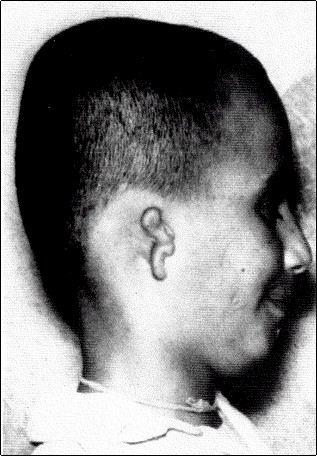
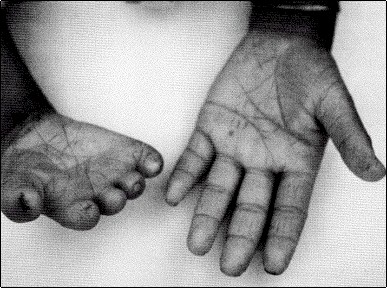
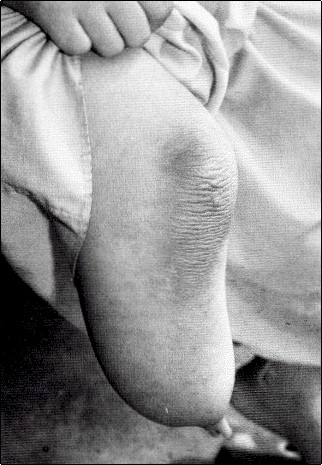
Figure 8. shows the right side of the head of a Turkish boy with a diminished and malformed ear (unilateral microtia). He also had underdevelopment of the right side of his face (hemifacial microsomia). He said that he remembered the life of a man who had been shot (with a shotgun) at point-blank range. The wounded man was taken to a hospital where he died 6 days later — of injuries to the brain caused by shot that had penetrated the right side of the skull. (I obtained a copy of the hospital record.)
Figure 9. shows fingers almost absent congenitally on one hand (unilateral brachydactyly) in a child of India who said he remembered the life of another child who had put his right hand into the blades of a fodder-chopping machine and lost his fingers. Most cases of brachydactyly involve only a shortening of the middle phalanges. In the present case there were no phalangeal bones, and the fingers were represented by mere stubs. Unilateral brachydactyly is exceedingly rare, and I have not found a published report of a case, although a colleague (plastic surgeon) has shown me a photograph of one case that came under his care.
Figure 10. shows congenital absence of the lower right leg (unilateral hemimelia) in a Burmese girl. She said that she remembered the life of a girl who was run over by a train. Eyewitnesses said that the train severed the girl’s right leg first, before running over the trunk. Lower hemimelia is an extremely rare condition, and Frantz and O’Rahilly (1961) found it in only 12 (4.0%) of 300 cases of all congenital skeletal deficiencies that they examined.
8. Discussion
Because most (but not all) of these cases develop among persons who believe in reincarnation, we should expect that the informants for the cases would interpret them as examples according with their belief; and they usually do. It is necessary, however, for scientists to think of alternative explanations.
The most obvious explanation of these cases attributes the birthmark or birth defect on the child to chance, and the reports of the child’s statements and unusual behavior then become a parental fiction intended to account for the birthmark (or birth defect) in terms of the culturally accepted belief in reincarnation. There are, however, important objections to this explanation. First, the parents (and other adults concerned in a case) have no need to invent and narrate details of a previous life in order to explain their child’s lesion. Believing in reincarnation, as most of them do, they are nearly always content to attribute the lesion to some event of a previous life without searching for a particular life with matching details. Second, the lives of the deceased persons figuring in the cases were of uneven quality both as to social status and commendable conduct. A few of them provided models of heroism or some other enviable quality; but many of them lived in poverty or were otherwise unexemplary. Few parents would impose an identification with such persons on their children. Third, although in most cases the two families concerned were acquainted (or even related), I am confident that in at least 13 cases (among 210 carefully examined with regard to this matter) the two families concerned had never even heard about each other before the case developed. The subject’s family in these cases can have had no information with which to build up an imaginary previous life which, it later turned out, closely matched a real one. In another 12 cases the child’s parents had heard about the death of the person concerned, but had no knowledge of the wounds on that person. Limitations of space for this article oblige me to ask readers to accept my appraisal of these 25 cases for this matter; but in my forthcoming work I give a list of the cases from which readers can find the detailed reports of the cases and from reading them judge this important question for themselves. Fourth, I think I have shown that chance is an improbable interpretation for the correspondences in location between two or more birthmarks on the subject of a case and wounds on a deceased person.
Persons who reject the explanation of chance combined with a secondarily confected history may consider other interpretations that include paranormal processes, but fall short of proposing a life after death. One of these supposes that the birthmark or birth defect occurs by chance and the subject then by telepathy learns about a deceased person who had a similar lesion and develops an identification with that person. The children subjects of these cases, however, never show paranormal powers of the magnitude required to explain the apparent memories in contexts outside of their seeming memories.
Another explanation, which would leave less to chance in the production of the child’s lesion, attributes it to a maternal impression on the part of the child’s mother. According to this idea, a pregnant woman, having a knowledge of the deceased person’s wounds, might influence a gestating embryo and fetus so that its form corresponded to the wounds on the deceased person. The idea of maternal impressions, popular in preceding centuries and up to the first decades of this one, has fallen into disrepute. Until my own recent article (Stevenson, 1992) there had been no review of series of cases since 1890 (Dabney, 1890); and cases are rarely published now (Williams and Pembroke, 1988). Nevertheless, some of the published cases — old and new — show a remarkable correspondence between an unusual stimulus in the mind of a pregnant woman and an unusual birthmark or birth defect in her later-born child. Also, in an analysis of 113 published cases I found that the stimulus occurred to the mother in the first trimester in 80 cases (Stevenson, 1992). The first trimester is well known to be the one of greatest sensitivity of the embryo/fetus to recognized teratogens, such as thalidomide (Nowack, 1965) and rubella (Hill, Doll, Galloway, and Hughes, 1958). Applied to the present cases, however, the theory of maternal impression has obstacles as great as the normal explanation appears to have. First, in the 25 cases mentioned above, the subject’s mother, although she may have heard of the death of the concerned deceased person, had no knowledge of that person’s wounds. Second, this interpretation supposes that the mother not only modified the body of her unborn child with her thoughts, but after the child’s birth influenced it to make statements and show behavior that it otherwise would not have done. No motive for such conduct can be discerned in most of the mothers (or fathers) of these subjects.
It is not my purpose to impose any interpretation of these cases on the readers of this article. Nor would I expect any reader to reach even a preliminary conclusion from the short summaries of cases that the brevity of this report entails. Instead, I hope that I have stimulated readers to examine the detailed reports of many cases that I am now in the process of publishing (Stevenson, forthcoming). “Originality and truth are found only in the details” (Stendhal, 1926).
9. Acknowledgements
I am grateful to Drs. Antonia Mills and Emily W. Cook for critical comments on drafts of this paper. Thanks are also due to the Bernstein Brothers Parapsychology and Health Foundation for the support of my research.
Correspondence and requests for reprints should be addressed to: Ian Stevenson, M.D., Division of Perceptual Studies, Box 152, Health Sciences Center, University of Virginia, Charlottesville, VA 22908
10. References
Cockayne, E, A. (1933). Inherited abnormalities of the skin. London: Oxford University Press.
Cook, E. W., Pasricha, S, Samararatne, G, Win Maung, & Stevenson, I. (1983). Review and analysis of “unsolved” cases of the reincarnation type: II. Comparison of features of solved and unsolved cases, Journal of the American Society for Psychical Research, 77, 1 15-135.
Dabney, W. C. (1890). Maternal impressions. In J. M. Keating (Ed.), Cyclopaedia of the diseases of children, Vol. 1 , (pp. 191-216). Philadelphia: J. B. Lippincott.
Denaro, S. J. ( 1944). The inheritance of nevi. Journal of Heredity, 35, 2 1 5- 1 8.
Fatteh, A. (1976). Medicolegal investigation of gunshot wounds. Philadelphia: J. B. Lippincott.
Frantz, C. H., & O’Rahilly, R.(1961). Congenital skeletal limb deficiencies. Journal of Bone and Joins Surgery: 43-A, 1202-24.
Gordon, I., & Shapiro, H. A. (1982). Forensic medicine: A guide to principles. (2nd ed.) London: Churchill Livingstone.
Hill, A, B,, Doll, R,, Galloway, T. M., & Hughes, J.P.W. (1958). Virus diseases in pregnancy and congenital defects. (PDF). British Journal of Preventive and Social Medicine, 12, 1-7.
Maruri, C. A. (1961). La herencia en dermarologia. PDF icon. (2nd ed.) Santander: Aldus, S.A. Artes Graficas.
Mills, A. (1989). A replication study: Three cases of children in northern India who are said to remember a previous life. (PDF). Journal of Scientific Exploration, 3, 133-184.
Nelson, K., & Holmes, L. B. (1989). Malformations due to presumed spontaneous mutations in newborn infants. New England Journal of Medicine, 320, 19-23.
Nowack, E, (1965). Die sensible Phase bei der Thalidomid-Embryopathie. Humangenetik, I, 516-36.
Pack, G. T., & Davis, J. (1956). Moles. New York Stare Journal of Medicine, 56, 3498-3506.
Pack, G. T., Lenson, N. & Gerber, D. M. (1952). Regional distribution of moles and melanomas. (PDF). AMA Archives of Surgery. 65, 862-70.
Smith, D. W. (1982). Recognizable patterns of human malformation. (3rd ed.) Philadelphia: W. B. Saunders.
Spalteholz. W (1943). Hand atlas of human anatomy. Translated by L. E Barker. 7th English ed. Philadelphia: J,B. Lippincott.
Stendhal (1926). Lucien Leuwen. Paris: Librairie Ancienne Honor6 Champion, 4, 169.
Stevenson, I. (1975). Cases of the reincarnation type. I. Ten cases in India. Charlottesville: University Press of Virginia.
Stevenson, I. (1983). American children who claim to remember previous lives. (PDF). Journal of Nervous and Mental Disease, 17 1, 742-748.
Stevenson, I. (1987). Children who remember previous lives. Charlottesville: University Press of Virginia.
Stevenson, I. ( 1990). Phobias in children who claim to remember previous lives. (PDF). Journal of Scientific Exploration, 4, 243-254.
Stevenson, I. (1992). A new look at maternal impressions: An analysis of 50 published cases and reports of two recent examples. (PDF). Journal of Scientific Exploration, 6, 353-373.
Stevenson, I. Birthmarks and birth defects: A contribution to their etiology. Amazon.com
Williams, H. C., & Pembroke, A. C. (1988). Naevus of Jamaica. Lancer, 11, 915.
Wilson, J. G. (1973). Environment and birth defects. New York: Academic Press.
11. Articles on Reincarnation by Researchers of the Division of Perceptual Studies
All articles below are in PDF format. To download, right-click on the link and select “Save As”. Related articles can be downloaded at the Division of Perceptual Studies at the University of Virginia.
• The Evidence for Survival from Claimed Memories of Former Incarnations (PDF). by Dr. Ian Stevenson. (Journal of the American Society for Psychical Research 54:51-71 and 95-117, 1960). Dr. Stevenson’s early essay about cases suggestive of reincarnation and several interpretations of them.
• Some Questions Related to Cases of the Reincarnation Type (PDF). by Dr. Ian Stevenson. (Journal of the American Society for Psychical Research 68:395-416, 1974). A discussion of some frequently asked questions about reincarnation.
• A Preliminary Report of a New Case of Responsive Xenoglossy: The Case of Gretchen (PDF). by Dr. Ian Stevenson. (Journal of the American Society for Psychical Research 70:65-77, 1976). A report of a case in which the subject, under hypnosis, spoke and conversed in German, a language that she seems not to have learned normally.
• The Explanatory Value of the Idea of Reincarnation (PDF). by Dr. Ian Stevenson. (Journal of Nervous and Mental Disease. 164:305-326, 1977). A consideration of the ways in which the concept of reincarnation might supplement those of heredity and environment in explaining some poorly understood aspects of human behavior and development.
• The Southeast Asian Interpretation of Gender Dysphoria: An Illustrative Case Report (PDF). by Dr. Ian Stevenson. (Journal of Nervous and Mental Disease. 165:201-208, 1977). Suggesting that gender identity confusion may derive from influences of a previous life as a member of the opposite sex, Dr. Stevenson reports the case of a girl who claims to remember a previous life as a man.
• A Preliminary Report on an Unusual Case of the Reincarnation Type with Xenoglossy (PDF). by Dr. Ian Stevenson. (Journal of the American Society of Psychical Research 74: 331-348, 1980). A report of a case of a woman who periodically assumes a second personality, speaking only a language she does not know in her normal state. She has also given verified details about another life she claims to have lived.
• American Children Who Claim to Remember Previous Lives (PDF). by Dr. Ian Stevenson. (Journal of Nervous and Mental Disease. 171:742-748, 1983). Report of an analysis of 79 cases of American children who claim to remember a previous life.
• A Review and Analysis of “Unsolved” Cases of the Reincarnation Type: I. Introduction and Illustrative Case Reports (PDF). by Dr. Ian Stevenson, Dr. Emily Williams Cook et al. (Journal of the American Society for Psychical Research 77:45-62, 1983). Brief reports of 7 cases of the reincarnation type in which no deceased person corresponding to the child subject’s statements has been found.
• A Review and Analysis of “Unsolved” Cases of the Reincarnation Type: II. Comparison of Features of Solved and Unsolved Cases (PDF). by Dr. Ian Stevenson, Dr. Emily Williams Cook et al. (Journal of the American Society for Psychical Research 77:115-135, 1983). Report of an analysis and comparison of 856 solved and unsolved reincarnation cases with regard to 9 important features.
• The Belief in Reincarnation Among the Igbo of Nigeria (PDF). by Dr. Ian Stevenson. (Journal of Asian and African Studies XX:13-30, 1985.) A summary of the belief in reincarnation among the Igbo with a description of the repeater children, called ogbanjes by the Igbo people.
• Characteristics of Cases of the Reincarnation Type Among the Igbo of Nigeria (PDF). by Dr. Ian Stevenson. (Journal of Asian and African Studies XXI:204-216, 1986). A description of the principle features found in 57 cases of the reincarnation type occurring among the Igbo people. Several tables compare the incidence of the main features of the cases in nine or ten different cultures.
• Indian Cases of the Reincarnation Type Two Generations Apart (PDF). by Dr. Ian Stevenson and Dr. Satwant Pasricha. (Journal of the Society for Psychical Research 54(809):239-246, 1987). Cases of the reincarnation type from the early years of this century show features closely resembling those of cases whose subjects were born after 1965.
• Deception and Self-Deception in Cases of the Reincarnation Type: Seven Illustrative Cases in Asia (PDF). by Dr. Ian Stevenson, Dr. Satwant Pasricha and Godwin Samararatne. (Journal of the American Society for Psychical Research 82:1-31, 1988). Detailed reports of 7 cases of the reincarnation type in Asia that seemed to be authentic at first but, on investigation, proved to be best interpreted as instances of deception or self-deception.
• Two Correlates of Violent Death in Cases of the Reincarnation Type (PDF). by Dr. Ian Stevenson and Dr. N. K. Chadha. (Journal of the Society for Psychical Research 55(811):71-79, 1988). In the cases of children remembering previous lives that ended violently the interval between death of the deceased person whose life is remembered and the subject’s birth is shorter, on average, than in cases having a natural death in the previous life. Also, children remembering violent deaths tend to speak about the previous life at an earlier age than do children who remember lives that ended naturally.
• Three New Cases of the Reincarnation Type in Sri Lanka with Written Records Made before Verification (PDF). by Dr. Ian Stevenson. (Journal of Nervous and Mental Disease. 176:741, 1988). Short summaries of three recent cases of the valuable type in which the child’s statements were recorded in writing before they were verified.
• Three New Cases of the Reincarnation Type in Sri Lanka with Written Records Made before Verification (PDF). by Dr. Ian Stevenson and Godwin Samararatne. (Journal of Scientific Exploration 2:217-238, 1988). A longer version of 15a, including more detail about the 3 cases reported.
• Phobias in Children Who Claim to Remember Previous Lives (PDF). by Dr. Ian Stevenson. (Journal of Scientific Exploration 4:243-254, 1990). A discussion of the phobias that occur among many children who seem to remember a previous life, and some possible explanations for these phobias.
• Birthmarks and Birth Defects Corresponding to Wounds on Deceased Persons (PDF). by Dr. Ian Stevenson. (Journal of Scientific Exploration 7:403-410, 1993). A short summary of research on the cases of children who claim to remember previous lives and who have birthmarks or birth defects that correspond to wounds in the claimed previous life.
• Does the Socio-Psychological Hypothesis Explain Cases of the Reincarnation Type? (PDF). by Dr. Ian Stevenson and Dr. Sybo Schouten. (Journal of Nervous and Mental Disorder. 186:504-506, 1998). Cases of the reincarnation type (in India and Sri Lanka) in which a written record of the subject’s statements was made only after the families concerned had met did not have more statements and more correct ones than cases in which a written record was made before the statements were verified.
• Do Cases of the Reincarnation Type Show Similar Features Over Many Years? A Study of Turkish Cases a Generation Apart (PDF). by Dr. Jürgen Keil and Dr. Ian Stevenson. ( Journal of Scientific Exploration 13(2):189-198, 1999). In Turkey the features of 45 cases studied by one investigator were compared with the features of 45 other cases studied nearly a generation later by another investigator. Overall, the two groups of cases showed closely similar features. The cases appear to be a natural phenomenon occurring over many years.
• The Phenomenon of Claimed Memories of Previous Lives: Possible Interpretations and Importance (PDF). by Dr. Ian Stevenson. (Medical Hypotheses 54(4):652-659, 2000). The hypothesis of previous lives can contribute to the further understanding of several conditions, disorders, or abnormalities (such as phobias observed in early infancy, gender identity disorder, and behavioral and physical differences in one-egg [monozygotic] twins) that are not adequately explained by genetic and/or environmental influences.
• The Stability of Assessments of Paranormal Connections in Reincarnation-Type Cases (PDF). by Dr. Ian Stevenson and Dr. Jürgen Keil. (Journal of Scientific Exploration 14 (3): 365-382, 2000). Fifteen cases of children who claimed to remember a previous life were investigated twice and independently with an average interval of 22 years between the investigations. The reports were evaluated for evidence of a paranormal process. With the lapse of time informants lost some details; but with one possible exception there was no evidence of increased claims of paranormality in the later investigations.
• An Unusual Birthmark Case Thought to be Linked to a Person Who Had Previously Died (PDF). by Dr. Jürgen Keil and Dr. Jim B. Tucker. (Psychological Reports 87:1067-1074, 2000). A report of a case of a Burmese subject who was born with birthmarks and birth defects that were thought to be linked to the death of his mother’s first husband in a parachute accident.
• A Scale to Measure the Strength of Children’s Claims of Previous Lives: Methodology and Initial Findings (PDF) by Dr. Jim B. Tucker. (Journal of Scientific Exploration 14(4):571-581, 2000). 799 cases of children who claim to remember a previous life were analyzed using a scale that measured the strength of the claims. The analysis showed that in the stronger cases, the children tended to start talking about the previous life at an earlier age; they demonstrated more emotion in recalling the past life; and they showed greater facial resemblance to the deceased individual that they were said to have been.
• Unusual Play in Young Children Who Claim to Remember Previous Lives (PDF). by Dr. Ian Stevenson ( Journal of Scientific Exploration 14(4):557-570, 2000). Children who, when they learn to speak express memories of previous lives, frequently engage in play that is unusual and has no model or other obvious stimulus in their family. The play seems to repeat the vocation or an avocation of the person whose life the child seems to remember. Sometimes the play reenacts the cause of death, such as drowning, of that person.
• Ropelike Birthmarks on Children Who Claim to Remember Past Lives (PDF). by Dr. Ian Stevenson (Psychological Reports 89:142-144, 2001). Description of birthmarks having the pattern of strands of a rope in a second known case includes some verification of the correspondence between the birthmarks and injuries from ropes on an identified deceased person.
• Can Cultural Beliefs Cause a Gender Identity Disorder? (PDF). by Dr. Jim B. Tucker and Dr. Jürgen Keil. (Journal of Psychology & Human Sexuality 13(2):21-30, 2001). Report of a child in Thailand who was born with a birthmark that matched a mark made on the body of his deceased grandmother. As he got older, he claimed to be his grandmother reborn, and he demonstrated cross-gender behavior.
• The Similarity of Features of Reincarnation Type Cases over Many Years: A Third Study (PDF). by Dr. Ian Stevenson and Dr. Erlendur Haraldsson. ( Journal of Scientific Exploration 17(2):283-289, 2003). The principal features of two series of cases suggestive of reincarnation in Lebanon were compared. The series were investigated about a generation apart by two different investigators. In three important features the two series were closely similar; in other features they were not similar, probably because of differences in the thoroughness of investigation in the two series.
• Cases of the Reincarnation Type with Memories from the Intermission Between Lives (PDF). by Poonam Sharma and Dr. Jim B. Tucker. (Journal of Near-Death Studies 23(2):101-118, 2005). A minority of children who claim to remember previous lives also claim to remember events between lives. This analysis of statements from 35 Burmese subjects reveals patterns in the memories that they described. A comparison of these reports to reports of near-death experiences indicates significant areas of overlap.
• Children Who Claim to Remember Previous Lives: Cases with Written Records Made before the Previous Personality Was Identified (PDF). by Dr. Jürgen Keil and Dr. Jim B. Tucker. (Journal of Scientific Exploration 19(1): pp. 91-101, 2005). A case is presented in which a written record, made before the deceased individual was identified, documented that the numerous statements made by a Turkish boy about a previous life were accurate for the life of a man who lived 500 miles away and died 50 years before the boy was born. Other similar cases are reviewed.
• Children of Myanmar Who Behave like Japanese Soldiers: A Possible Third Element in Personality (PDF). by Dr. Ian Stevenson and Dr. Jürgen Keil. (Journal of Scientific Exploration 19(2): pp. 171-183, 2005). Among 750 children of Myanmar who claimed to remember a previous life 24 spoke about having been Japanese soldiers killed, presumably during World War II. None gave verifiable information, but they all showed unusual behavior, such as insensitivity to pain, dislike of hot weather and, distaste for spicy food, which are typical of Japanese soldiers, but not of Burmese persons. Genetic factors cannot explain these cases; neither can encouragement of such behavior by the children’s parents. Reincarnation is suggested as a third component of human personality illustrated by these cases.
• Some Bodily Malformations Attributed to Previous Lives (PDF). by Dr. Satwant K. Pasricha, Dr. Jürgen Keil, Dr. Jim B. Tucker, and Dr. Ian Stevenson. (Journal of Scientific Exploration 19(3):359-383, 2005). This two part article examines cases in which children were born with abnormalities that were attributed to wounds from a previous life. Part I presents three cases in which evidence indicated a close correspondence between a child’s birthmark and a wound on a particular deceased person. Part II describes four cases of birth defects that were attributed to previous lives and looks at the evidence supporting that attribution. Photographs of the malformations are included.
• Children Who Claim to Remember Previous Lives: Past, Present, and Future Research (PDF). by Dr. Jim B. Tucker. (Journal of Scientific Exploration, 21(3): pp. 543-552, 2007). The research with Cases of the Reincarnation Type is reviewed, beginning with Ian Stevenson’s initial paper on the phenomenon in 1961. Current projects and planned future projects are also discussed.
• Ian Stevenson and cases of the reincarnation type (PDF). by Dr. Jim B. Tucker (Journal of Scientific Exploration, 22 (1); 36-43, 2008). Ian Stevenson began studying children who claim to remember previous lives — an endeavor that will surely be remembered as the primary focus of his life’s work — almost by accident. Enjoying a successful mainstream career with some 60 publications in the medical and psychiatric literature to his credit, he had become chairman of the Department of Psychiatry and Neurology at the University of Virginia in 1957.
• Children’s reports of past-life memories: A review (PDF). by Dr. Jim B. Tucker, (EXPLORE: The Journal of Science and Healing, 4(4):244-248, 2008). Researchers have studied young children’s reports of past-life memories for the last 45 years. The children usually describe a recent, ordinary life, and many of them have given enough details so that one particular deceased individual has been identified to match the children’s statements. These cases occur worldwide, and although they are easiest to find in cultures with a belief in reincarnation, many cases have been found in the West as well. This review explores the facets of this phenomenon and presents several recent American cases.
• Review by Dr. Jim B. Tucker of “Can the Mind Survive beyond Death? In Pursuit of Scientific Evidence” (PDF). by Satwant K. Pasricha. (Journal of Scientific Exploration 24:133-137, 2010). This two-volume set is divided into 22 chapters, each consisting of a previously published article, with Pasricha being sole author or lead author of 17 of them. (Full disclosure: I am one of four authors of one paper.) Though most deal with what are called cases of the reincarnation type, related areas such as near-death experiences (NDEs) are addressed as well.
• Response to “How To Improve the Study and Documentation of Cases of the Reincarnation Type? A Reappraisal of the Case of Kemal Atasoy” (PDF). written by Vitor Moura Visoni. The response is by Dr. Jürgen Keil and Dr. Jim B. Tucker. (Journal of Scientific Exploration 24:295-296, 2010). The Essay by Vitor Moura Visoni in JSE, 24(1), Spring 2010, pp. 101–108, makes a number of criticisms of our Research Article “Children Who Claim To Remember Previous Lives: Cases with Written Records Made before the Previous Personality Was Identified,” JSE, 19(1), Spring 2005, pp. 91–101, which we will address by section.
• Experimental Birthmarks: New Cases of an Asian Practice (PDF). by Dr. Jim B. Tucker and Dr. Jürgen Keil. (Journal of Scientific Exploration 27:263-276, 2013). Experimental birthmarks involve a practice in several countries in Asia in which the body of a dying or recently deceased person is marked with a substance, most often soot, in the belief that when the individual is reborn, the baby will bear a birthmark corresponding to the mark. This is usually done with the expectation that the rebirth will occur in the same family as the deceased individual. A field study was undertaken in Thailand and Myanmar (Burma) to examine such cases. Eighteen cases were found in which a baby was born with a birthmark that corresponded to a marking made on the body of a deceased person; in six of these, the child also made statements that the family believed were related to the life of the deceased individual. Possible etiologies for these cases are explored..
• A Case of the Possession Type in India with Evidence of Paranormal Knowledge (PDF). by Ian Stevenson et al. (Journal of Scientific Exploration. Vol. 3, No. I, pp. 81-101, 1989). A young married woman, Sumitra, in a village of northern India, apparently died and then revived. After a period of confusion she stated that she was a person named Shiva who had been murdered in another village. She gave enough details to permit verification of her statements, which corresponded to facts in the life of another young married woman called Shiva. Extensive interviews with 53 informants satisfied the investigators that the families concerned had been, as they claimed, completely unknown to each other before the case developed and that Sumitra had had no normal knowledge of the people and events in Shiva’s life. The authors conclude that the subject demonstrated knowledge of another person’s life obtained paranormally.
• Psychological Evaluation of American Children Who Report Memories of Previous Lives (PDF). by Jim Tucker et al. (Journal of Scientific Exploration, Vol. 28, No. 4, pp. 583–594, 2014). Some young children claim to have memories of a previous life, and they often show behaviors that appear related to the memories. This pilot study examined the psychological functioning of such children in the United States. Fifteen participants, ages 3–6 years, underwent testing with the Stanford-Binet Intelligence Scale (fourth edition) and the Children’s Apperception Test. The children’s composite intelligence scores on the Stanford-Binet were greater than one standard deviation above the mean, with relative strengths in verbal reasoning and quantitative reasoning.


